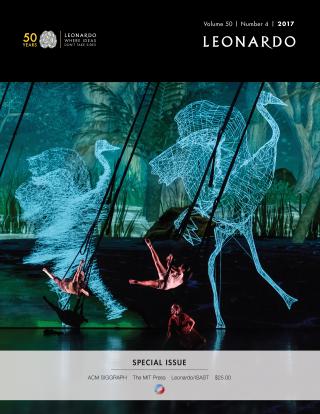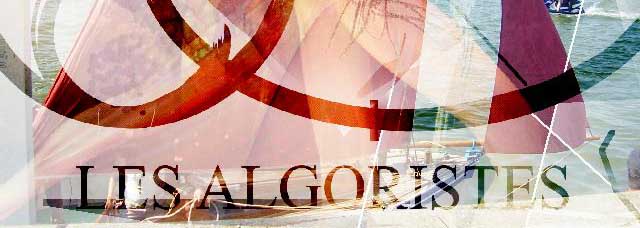
The Siggraph 2027
dedicated issue of Leonardo
Siggraph Art Gallery: Latin America!
July 30- Aug. 3, 2017. Los Angeles More info
Unsettled Artifacts: Technological Speculations from Latin America
For the first time in Siggraph history, the Art Gallery is dedicated exclusively to works by Latin American artists and designers: speculative artifacts that apply digital technologies to map alternative futures. The gallery presents 10 provocative projects from seven countries: Argentina, Brazil, Chile, Colombia, Cuba, Ecuador, and México.
Uncertain. Agitated. Disobedient. Unstable. Troubled. Historically, the Latin American artifact has been, above all, an unsettled object of study. Recent decades have demonstrated the impossibility of reducing the Latin American artifact to a single homogeneous concept, simply because the idea of Latin America is itself unsettled. The Art Gallery illuminates this reality and reimagines possible new worlds. It explores technology-based artistic practices produced beyond the traditional centers of industrial and technological development in territory that is often underrepresented, excluded, or ignored in the global narrative, and it shares new insights on how Latin American artists create, adapt, and use technology to critically confront a rich cultural context shaped by long histories of imperialism, colonization, and global asymmetry.
A special issue of Leonardo, The Journal of the International Society of the Arts, Sciences and Technology includes visual documentation of the works exhibited.
The Papers
- “Creature:Interactions: A Social Mixed-Reality Playspace” by Andrew Bluff and Andrew Johnston- “The Interactive Image: A Media Archaeology Approach” by Esteban García Bravo, Andrés Burbano, Vetria L. Byrd, and Angus G. Forbes
- “Autoencoding Blade Runner: Reconstructing Films with Artificial Neural Networks” by Terence Broad and Mick Grierson
- “Avoid Setup: Insights and Implications of Generative Cinema” by Dejan Grba
- “Lenticular Waterwheels: Simultaneous Kinetic and Embedded Animation” by Scott Hessels
- “Transforming the Commonplace through Machine Perception: Light Field Synthesis and Audio Feature Extraction in the Rover Project” (Best Paper Award) by Robert Twomey and Michael McCrea.
The works
> BioSoNot 1.2 by Gilberto Esparza. A hybrid bio-sound instrument that translates biological activity into sound as it cleans contaminated water samples. It generates music and noise from the biological activity of living microorganisms. A series of custom-made microbial fuel cells (biosensors) captures electrons produced by the metabolic processes of bacteria in polluted rivers and urban municipal waters. This bio-electrical information is harvested and fired as energy into an oscillator that expresses the information as sound, generating an organic symphony of bacterial life.
> Milpa Polímera by Marcela Armas and Arcángel Constantini. A3D printer modified to function as a tractor that plants seeds made of polylactic acid, a thermoplastic biopolymer produced from a patented strain of corn. It paradoxically contradicts the very origins of corn: a plant domesticated about 10,000 years ago by a collective civilization whose cosmogony and culture saw it as a shared source of life. The machine is trapped in a perverse cycle derived from a strictly economic and market-driven logic (planting infertile seeds) that exposes the system behind the control of life and knowledge.
Milpa Polímera was originally conceived for Sin Origen/Sin Semilla, curated and directed by María Antonia González Valerio and Liliana Quintero as part of the research group BIOS Ex MachinA.
> Echolocalizator (2015 and after) by eHamilton Mestizo. A helmet that recreates physical reality within a biofeedback system, translating sensory stimuli into a new language for human interpretation. Visible phenomena are reinterpreted into synthesized sounds that generate new cognitive associations and perceptive experiences. By simulating the echolocation sonar used by animals like bats and dolphins, it highlights the essential role of technology in the co-evolution of humans and animals, and creates a perception-bending, environment-transforming portal to a world that simultaneously exists and does not exist.
It was a collaborative effort that began in 2015 at the Festival de la Imagen in Manizales, Colombia, and continued in the design laboratories of the Universidad de Caldas.
> The Andean Pavilion by Paul Rosero Contreras. A series of 3D-printed sculptures based on recordings of seismic waves at four active volcanoes in the highlands of Ecuador and the Galápagos Islands. Sound devices recorded the volcanic activity, and custom software converted the data to computational 3D models. The result is a series of hybrid objects that reenact momentary encounters between a volcano, a human, and a machine revealing a situation in which human-environmental dynamics are constantly redefined.
Astrovandalistas is a translocal collective that applies creative intervention, technological activism, urban hacking, and open-source knowledge to explore the industrialization of our social imagination. In 2014 and 2015, they created an alternative communication networks in El Paso-Juárez border region where they reimagined Nasa’s laser communication technology to engrave rocks with a glyphic alphabet of their own design. During this show , attendees use this system to engrave predictions onto rocks and city debris collected from the greater Los Angeles area. Part site-specific minimalist installation, part laboratory and workshop, this future-casting platform invites direct participation and creates an opportunity for manifesting anxieties about the future.
JailHead.com by Rodolfo Peraza. The artist explores the interiors of abandoned historical spaces designed for social engineering. JailHead.com uses internet surveillance technology to recreate one of the best panopticon buildings in the world: el Presidio Modelo, an abandoned prison in Isla de la Juventud, Cuba. As participants in this multi-player virtual-reality “game” become “inmates” identified by their IP addresses, they realize that we are all prisoners of the 21st century’s international system of observation and control.
> Sisyphean Octopods by Mariela Yeregui and Miguel Grassi. A group of six mobile robots that carry LCD screens displaying endoscopic videos with images that resemble internal body organs. The robots move erratically, without any purpose except to reveal their own technological animality; they display a corporeal behavior that is artificial and organic, material and phenomenological, exposing their own absurd existence as “living” artificial objects. Like Sisyphus, condemned to perform a laborious and futile task ad eternum, these mytho-technological beings were created to carry an image of themselves, and with that to define their own fate and identity.
> Anti-Horário (CounterClockwise) by Gisela Motta and Leandro Lima. A video installation and “wall clock” that addresses the cyclical movement of human existence, and the poetics of duration and perception. It combines several layered elements (the earth, a child, an adult couple, and the sky) moving at distinct cadences, registered from the same point of view, resulting in a disorienting analog clock. The second hand represents the child, and the minute hand represents the adults. Each revolution of the clock moves the child farther from the adults, representing the passage of time as well as the cycle of life.
> DrumCircle by Christian Oyarzún. An autonomous instrument composed of eight connected den-den drums mounted to LED spotlights to create a temporal and spatial network of machine-viewer interactions. Arranged in a circle pointing inward toward the center of the installation, these modules project light and sound patterns bidirectionally to create an immersive and ritualistic technological experience that illuminates how space and time are shaped by technology. They create relationships of dominance and meaning between subjects and objects, modifying our cognitive processes and the symbolic relationships we create with our environment.
> Dispersiones by Leo Nuñez. A site-specific physical network comprised of a series of interconnected relays that produce an artificial and interactive soundscape. The work appears to be a messy web of hundreds of tangled wires through which sounds travel, following an algorithm of artificial life. Using only the metallic clicking sound of the relays, the network behaves as a complex system of electromagnetic actuators that interact with the viewer. Each individual relay acts as a “living” agent that activates the space and the architecture. Once a viewer’s movement is detected, the system unleashes an infinite flow of sound and light.

